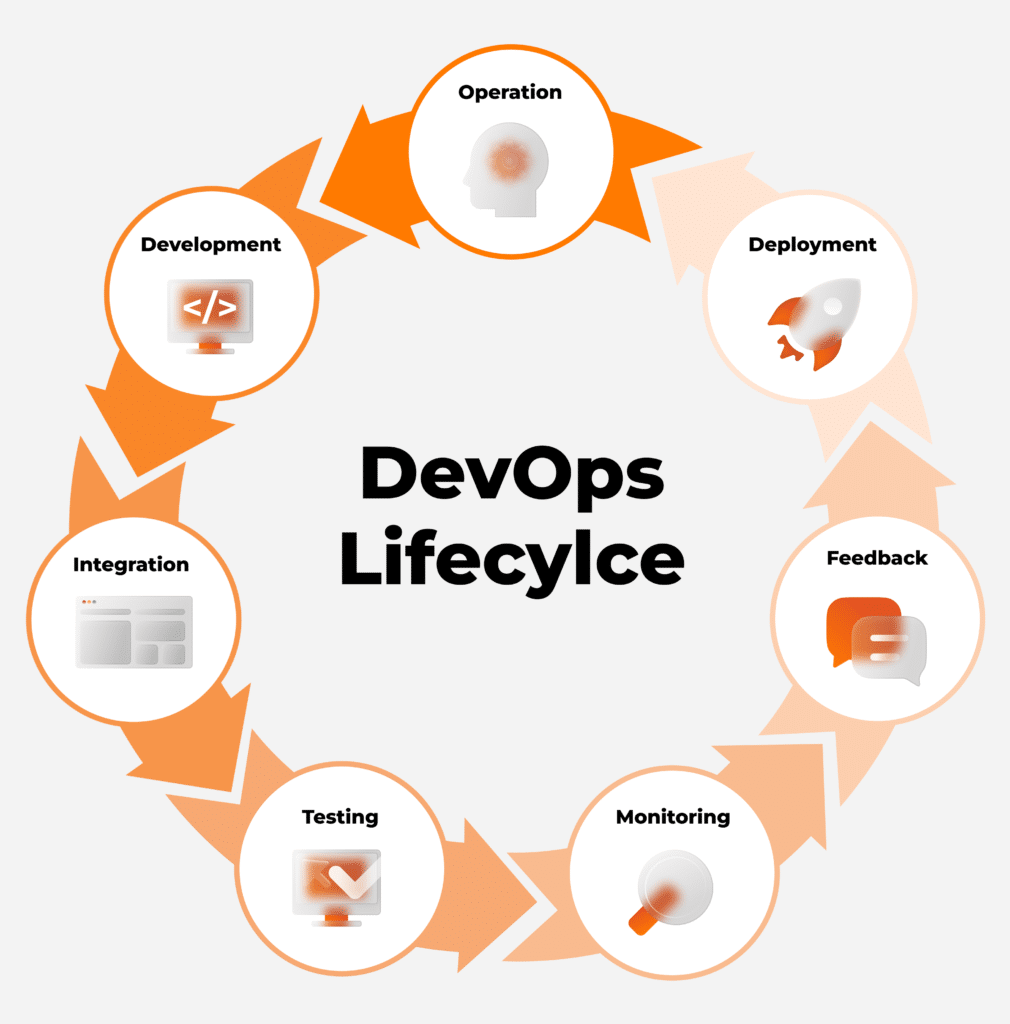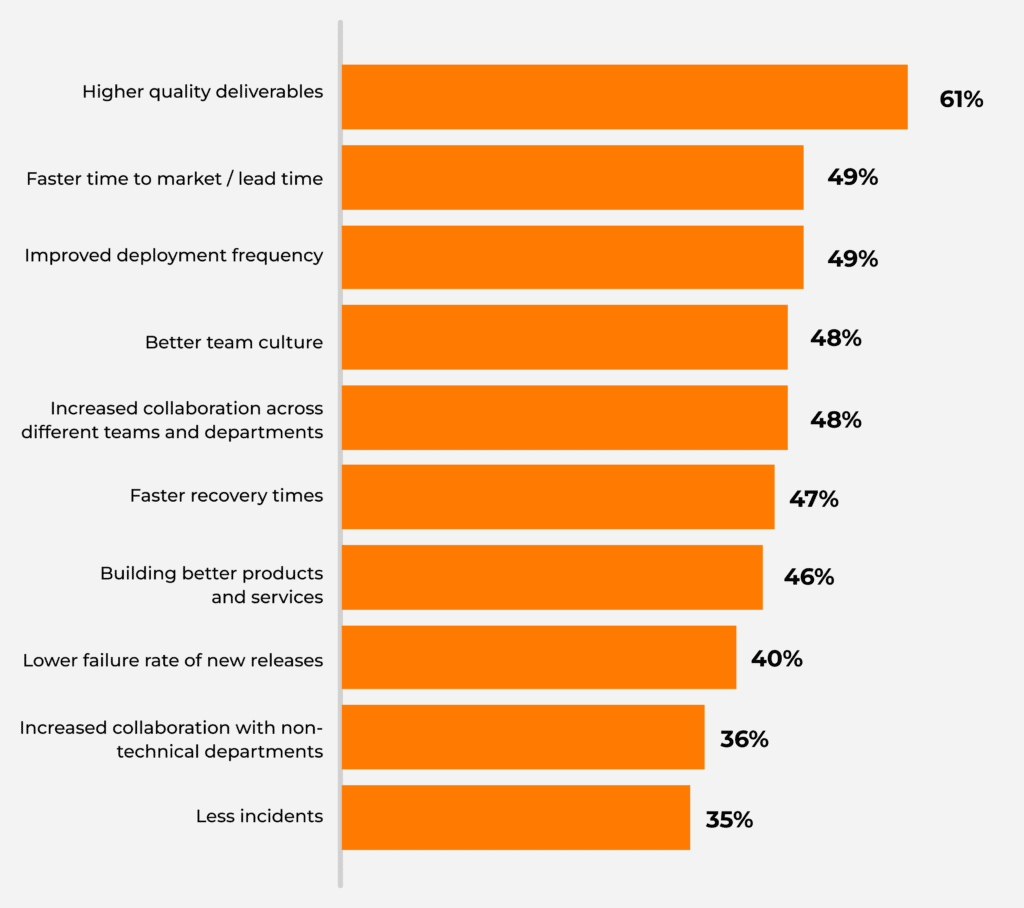Introduction
Over the past decade, DevOps has had a transformative impact on how companies manage their software engineering efforts. Yet, eight out of 10 companies practicing DevOps are barely in the middle of this transformation. At most companies, DevOps adoption only propagates to team level, with a long way to go before it can reach organization level. It seems that scaling DevOps is a challenge in itself, so let’s look at how companies can solve it.

Source: Puppet
Getting the basics right: what is DevOps?
DevOps is a collaborative methodology that connects software development and operations to streamline and accelerate the application lifecycle. Think of DevOps as both an evolution and a complementary aspect of agile development practices. DevOps builds upon agile, extending it to encompass processes like delivery and maintenance and turning cross-functional collaboration into a more intentional and concerted process.

For most organizations, this process includes the following components:
- Continuous development, an iterative approach that simplifies product development by breaking it down into smaller, more manageable cycles.
- Continuous integration automates and streamlines the incorporation of code changes from multiple contributors into the main branch.
- Continuous testing integrates automated test execution into the software delivery pipeline, enabling faster feedback on software quality.
- Continuous monitoring enables an automated tracking of system health while focusing on metrics related to compliance, security, or performance.
- Continuous feedback leverages regular evaluations of and reporting on the effects of software releases, enabling teams to quickly identify improvement areas.
- Continuous deployment automates the rollout of software functionality, allowing developers to validate changes and quickly address any potential issues.
- Continuous operations streamline maintenance and reduce planned downtime, minimizing disruption for end-users.
Key DevOps metrics

When evaluating the efficiency of their DevOps efforts, most companies will start with four high-level metrics:
- Deployment frequency shows how often new code changes are released into production, offering a clear picture of the pace of development and delivery.
- Change lead time reflects the efficiency of turning code changes into deployed features, revealing how quickly development efforts translate into usable updates.
- Mean time to recovery is the average time taken to resolve disruptions or failures, indicating how swiftly issues are addressed to restore normal system operation.
- Change failure rate highlights the percentage of changes resulting in issues that require fixing post-deployment, shedding light on the reliability of the deployment process.
How to scale DevOps: key focus areas
In scaling DevOps practices, organizations undergo a paradigm shift in their approach to software product development and deployment. This shift represents more than just a new methodology; it embodies a cultural transformation with profound implications for workflows and a wide-scale impact on business outcomes:

Source: The 2020 Atlassian DevOps trends survey
Scaling DevOps entails a synchronized evolution of your teams, processes, and tools. This means investing in talent, refining workflows, and leveraging the right technologies.
Teams
While the DevOps pipelines are, essentially, sets of automation tools, it’s people using these tools that make the most difference. When scaling DevOps, you need to ensure that your automation solutions are beneficial to diverse groups of experts within your organization, not just dedicated DevOps practitioners.
Solving this challenge largely comes down to how you select talent and manage the DevOps adoption process. When hiring DevOps experts, screen for ability to tailor solutions to industry-specific and team-specific challenges. When expanding your DevOps footprint to new processes, start small and move incrementally, enabling teams to build confidence with new ways of working.
Processes
When adopting the pipeline-as-code (PaC) approach, everyone involved gains access to the tools they need, whether they’re on the development or operations team. Integrated version control ensures that changes are tracked, making it simple for everyone to collaborate and share feedback.
With PaC, you can easily roll back to previous configurations if something goes wrong, providing a safety net for your projects. By standardizing and automating pipelines, you create consistency across teams, reducing confusion and making it easier for everyone to work together effectively.
Tools
Selecting the right CI/CD tools for DevOps scaling is crucial for sustained success. You need tools that can handle team growth, facilitate auto-scaling, enable quick recovery from issues, and ensure high availability. These tools should grow with your organization and be flexible to meet the diverse needs of different teams and technologies.
Your company likely has multiple teams working on different projects ranging from legacy apps and monolithic architectures to microservices. Your chosen tools need to be robust and adaptable enough to handle this diversity effectively.
Common challenges when scaling DevOps
84% of companies experience difficulties in their DevOps implementation with challenges ranging from siloed teams to tools, security, and governance. Let’s look at these challenges and common ways to address them.
Cultural resistance
Breaking down silos isn’t just about putting different teams in the same room; it’s about fostering genuine connections and collaboration. That means organizing cross-functional workshops or team-building activities to connect people from different departments. If silos are still a part of your organization or department culture, start by encouraging regular open forums or town hall meetings where everyone can share ideas and concerns.
Toolchain complexity
Managing a complex tool ecosystem in DevOps can lead to inefficiencies, hampering scaling. Identify redundant tools and streamline your toolkit to focus only on essential ones. Embrace infrastructure as code principles to automate provisioning and configuration management, saving time and reducing errors.
Manual processes
Manual testing and other manual processes hinder agility and introduce inefficiencies. By automating repetitive tasks and implementing robust DevOps automation frameworks, organizations can streamline workflows and accelerate delivery cycles.
Security concerns
The rapid deployment of code can increase the attack surface, leaving systems vulnerable to potential threats. When scaling DevOps practices, organizations must prioritize security from the outset. Security practices such as code scanning, vulnerability assessments, and automated compliance checks should be seamlessly integrated into the CI/CD pipeline.
Governance concerns
Automating compliance checks through policies as code (PaC) ensures uniformity across infrastructures and teams. This approach fosters agility while upholding control and compliance with regulatory standards.
DevOps best practices when scaling to an enterprise level
Shift the culture
Begin by fostering a culture of transparency, trust, and empathy within teams. Break down silos through cross-functional collaboration and shared ownership of projects. Embrace a “you build it, you run it” mentality, empowering teams to take ownership of both development and operations.
Identify pain points and set goals
Understand your teams’ objectives by gathering insights on critical areas of improvement from relevant stakeholders. Map these insights to specific metrics like lead time and deployment frequency and use them to evaluate processes, pinpoint bottlenecks, and set goals. Make sure to track your progress towards the chosen goals and adjust your metrics to align with your ever-evolving objectives.
Monitor progress
In DevOps, employing a sufficiently wide range of monitoring tools is crucial for automating, defining, and assessing development processes across the pipeline. These tools are vital for organizations to maintain the performance, availability, and overall health of their IT systems. This approach not only boosts operational efficiency but also fosters a culture of continuous improvement, ensuring consistent delivery of high-quality services.
Standardize
Establish standardized project templates and policies to foster consistency, streamline workflows, and enable replication of best practices across projects. Built-in templates offered by DevOps tools facilitate automation repetitions and ensure compliance with security and regulatory requirements.
Pay attention to UX and user feedback
With user research and testing, you can gain valuable insights into user perceptions and evolving needs, enhancing your product iteratively. Surveys, ticketing systems, and interdepartmental meetings facilitate gathering relevant feedback for informed design decisions.
Move one change at a time
In enterprise-scale DevOps, it’s essential that you follow an incremental approach, focusing on one change at a time and managing complexity. Make sure your team can continuously evaluate the effectiveness of changes, soliciting feedback for refinement from departments across the organization.
Where to start: choose the right partner
Scaling DevOps is a challenge that requires comprehensive expertise spanning engineering and management. While building your own DevOps team is definitely a viable option, leveraging consultancy firms offering DevOps as a Service (DaaS) can yield better results in a shorter timespan. Additionally, DevOps consultancies can help boost your DevOps capabilities with hard-to-find talent and highly cost-efficient engineering resources.
AgileEngine offers top-1% global engineers at 2X lower rates compared to talent costs in the US
If your organization is open to engaging third-party DevOps expertise, AgileEngine is always happy to explore new potential collaborations. Our track record includes Fortune 500 enterprises, VC startups, and numerous product and SaaS companies. The solutions delivered by our DevOps experts and dedicated teams include:
- Infrastructure as code (IaC) for a supply-chain ML platform top-listed by Gartner
- AWS DevOps solutions for a Stanford GSE partner and a staffing app used by Hilton and Hyatt
- CI/CD for a real estate platform used by 47 out of the top-50 US lenders
- Monitoring and distributed logging for a fintech that analyzes 24,000 transactions per second
- Dockerization solutions for the most-funded startup in France
- Up to 70% reduction of AWS costs through cloud optimization, Kubernetes adoption, and other solutions
Conclusion
Scaling DevOps represents a transformative journey for organizations, involving not only the adoption of new methodologies but also a cultural shift towards collaboration, automation, and continuous improvement.
While challenges may arise, addressing them strategically is essential for success. Partnering with a trusted DevOps consulting firm like AgileEngine can significantly facilitate this process, offering access to top-tier expertise and proven DevOps solutions that lead to high speed, quality, and resilience. Contact us to explore the range of services and level of expertise we offer across focus areas like DevOps, full-stack development, QA/AQA, and more.




